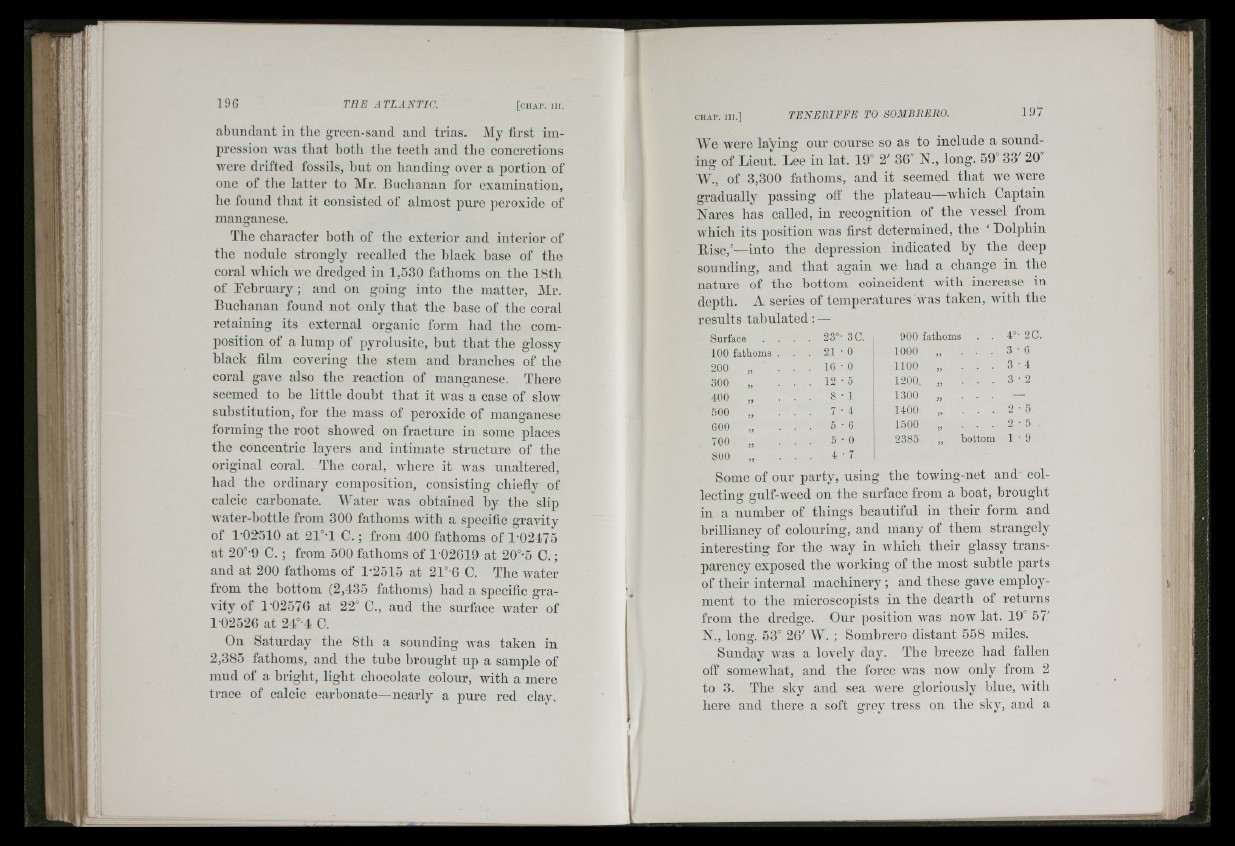
m
196 T H E A T L A N T I C .
■ A'! i*
'Li'
f K . p.. : F '
- A
I ’
[ c h a p . II I.
abundant in the green-saud and trias. My first impression
Avas that both the teeth and the concretions
AA'ere drifted fossils, but on liauding over a portion of
one of tiie latter to Mr. Buchauan for examination,
he found tliat it consisted of almost pure peroxide of
manganese.
The character both of the exterior and interior of
the nodule strongly recalled the hlack base of the
coral Avhich Ave dredged in 1,530 fathoms on the 18th
of February; and on going into the matter, Mr.
Buchanan found not only that the base of the coral
retaining its external organic form had the composition
of a lump of pyrolusite, but that the glossy
hlack film covering the stem and branches of the
coral gave also the reaction of manganese. There
seemed to be little doubt that it AA'as a case of sIoav
substitution, for the mass of peroxide of manganese
forming the root shoAved on fracture in some places
the concentric layers and intimate structure of the
original coral. The coral, Avliere it AA'as unaltered,
had the ordinary composition, consisting chiefiy of
calcic carbonate. IVater Avas obtained hy the slip
Avater-hottle from 300 fathoms Avith a specific gravity
of 1-0^510 at 21°-1 C .; from 400 fathoms of 1-02475
at 20°-9 C .; from 500 fathoms of 1-02619 at 20°-5 C.;
aud at 200 fathoms of 1-2515 at 2r-6 C. The Avater
from the bottom (2,435 fathoms) had a specific gravity
of 1-02576 at 22° C., aud the surface Avater of
1-02526 at 24° 4 C.
Ou Saturday the 8th a sounding Avas taken iu
2,385 fathoms, aud the tuhe brought up a sample of
mud of a bright, light chocolate colour, Avith a mere
trace of calcic carbonate—nearly a pure red clay.
CIIAP. I I I .] T E N E R I F F E T O S O M B R E R O . 197
I'Ve Avere laying our course so as to include a sounding
of Lieut. Lee in lat. 19° 2' 36" N., long. 59° 33' 20
W., of 3,300 fathoms, and it seemed that Ave AA'ere
gradually passing off' the plateau—Avhich Captain
Nares has called, iu recognition of the vessel from
AA'hich its position Avas first determined, the ‘ Dolphin
Rise,’—iuto the depression indicated hy the deep
sounding, and that again Ave had a change iu the
nature of the hottom coincident Avith increase in
depth. A series of temperatures Avas taken, Avitli the
results tabulated ;—■
Surface . 23°- 3C. 900 fathoms . . 4°- 2C.
100 fathoms . . 2 1 - 0 1000 ,, . . . 3 • G
200 „ . 1 6 - 0 1100 J? . . . 3 ■ 4
300 „ . 1 2 - 5 1200 J, . . . 3 • 2
400 „ 8 • 1 1300 ,, . . . —
500 „ . 7 • 4 1400 ji . . . 2 • 5
600 „ . 5 • 6 1500 yy . . . 2 • 5
700 „ . 5 • 0 2385 ,, bottom 1 • 9
800 „ . 4 • 7
Some of our party, using the toAving-net and col
in a number of things beautiful in their form and
hrilliancy of colouring, aud many of them strangely
interesting for the Avay in Avhich their glassy transparency
exposed the AVorking of the most subtle parts
of their internal machinery ; and these gave employment
to the microscopists in the dearth of returns
from the dredge. Our position AA'as uoav lat. 19° 57'
N., long. 53° 26' W. ; Sombrero distant 558 miles.
Sunday AA'as a loA'ely day. The breeze had fallen
off somcAvhat, aud the force Avas uoav only from 2
to 3. The sky and sea AA'ere gloriously blue, Avith
here and there a soft grey tress ou the sky, and a
> *
ki. .